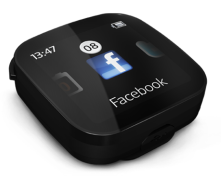Notification Devices
So what’s a smart watch, or smartwatch; in most cases it’s a device that has the looks of a futuristic watch used in a Razzie-award winning movie for worst props grossing over $100. I can still say this for now without the resistance of all the Apple Fanboys, Google +1-annoyers and Microsoft/Nokia-we-don’t-need-a-start-button people. Although these companies are surrounded by very strong rumors on releasing their own smart watches in the near future, any sane and objective discussion about the added value of these smart watches should be done now we still can!

The current generation of smart watches are display devices that are an extension to your smartphone. It’s a “Notification Device” that is connected through the Bluetooth functionality on your smartphone. In the dozen smart watches I have gone through most of its functionality is limited to notification of phone calls, text messages, social media and (music) control. Be aware, a 2013 smart watch is not a smart watch phone. It can’t be used fully without the nearby presence of your smartphone (9 meters / 30 feet). For some models it is possible to voice control the watch or even have a telephone conversation with it. (Flashback; KITT, Comlink, Michael Knight, anyone?!).
Besides the notification functionality the smart watches can also be equipped with 1 or more sensors like an accelerometer, camera or gyroscope. These sensors can come in handy for applications in the field of (health) monitoring, (ambient) interaction or (sports) logging.

DealeXtreme.com Devices
There are also smart watches available that can act as an alternative to the regular mobile device. These devices support SIM cards and 2G or 3G communication. Without making any verdicts (or predictions) on quality, sustainability, production ethics or safety; these devices are cheaper and support features like SD memory cards, USB, GPS and Wi-Fi. These smart watches, or “watch phones”, are available through channels like DealeExtreme or eBay. The extra usage possibilities for these (smart) watch phones are potentially better than the Notification Devices, but will it be a game changer in the classroom?
Usage cons
- Depending on the smart watch it will only work with a specific smartphone. Varying from Samsung SIII only to Android 4.1.0.3.8.6.5.9.3 and up. And from iOS to Blackberry 10+ (excluding SMS notification of course)
- It’s small; 1.3 – 1.6 inch displays with a limited number of pixels does not make a smart watch the ideal output device for web browsing, video playback, nor as input device for touch.
- Making phone calls or chatting is in most cases a private matter, it may be easier to do without grasping your smart phone or tablet out of your pocket, talking to a smart watch (in public) with the speakers on is not something most people prefer. The disentangling-your-headset-time could also be used for just picking up the call or VC session on your smartphone.
- There are no new functionalities in a smart watch compared to the smartphone. The only thing that is added is the notifications functionality that has gone up your sleeve to the wrist.
- Battery life on your smart watch and smartphone will be shortened due to the usage of Harald Blåtand Gormsen.
- And of course you need to use an app store for your smart watch apps. Unfortunately it won’t be one of your current 3 app stores you already have an account for.
Usage pros
- Cribbing and peeking should get easier with a smart watch for early adopters in the near future.
- Smart watches could be a stepping stone to the adoption and development of wearable technology innovations.
- It has a more elegant way of checking your notifications instead of checking your smart phone in a very anti-social manner during a presentation, conversation or class hours.
<smart watch rumours> Apple’s iWatch: 1,5″ display, organic light emitting diode displays, 2nd half 2014, biometric functionality, user identification. Google’s Gem: Bought WIMM Labs, 31 October 2013, Android 4.4 KitKat release. Microsoft: 4G connectivity, end of 2014, HTC former partner in smart watch exploration. Nokia: 疑是诺基亚智能手表曝光. LG: 2014, US first market, flexible displays. HTC: Android, camera, 2nd half 2014. </smart watch rumours>

Any experience?
At the moment of writing there are not a lot of publications or blogs on the internet about the educational or research usage of smart watches. Andreas Ødegård writes about his experience and ideas on the tech blog Pocketables. The described use-cases don’t really require a smartwatch, and it would be possible to do the same with a phone, tablet, or even a computer. At the moment this is a conclusion that is true for most smart watch scenarios within the field of education and research. The lack of (killer) apps and complementary functionalities seems to point out that these first generation watches won’t be the next big thing in class.
To further describe the potential NUtech.nl published a comprehensive article in Dutch about the past and future of smart watches. The 9 things smart watches should not forget either. What to think about: how new smartwatches could revolutionize the artefact surroundings of people (really). Kickstarter is also a starting point for some new smart watch ideas. And I certainly should not forget Dr Ngo An Tuan, the dean from the Ho Chi Minh City University of Technical Education in Vietnam and his view on smart watches.
Do you have any experience with the usage of smart watches within education or research? I invite you to share your experience, ideas, thoughts or possible next steps!
| Device | Status | Price | Smartphone OS needed | Display |
|---|---|---|---|---|
| Sony SmartWatch 2 | available | 159 eur | Android 4.0+ | 220×176, 1.6”LCD display |
| Sony SmartWatch | available | 130 usd | Android 2.1+ | 1.3” OLED display 128 x 128 pixels |
| Pebble | available | 150 usd | Apple, Android | 1.26-inch, 144 × 168 pixel e-paper display |
| Galaxy Gear-smartwatch | available | 299 usd | Galaxy Note 3 and Galaxy Note 10.1 2014 Edition, Galaxy S4, Galaxy S III, and Galaxy Note II | 1.63 inch 320×320 Super AMOLED |
| MetaWatch | available | 229 usd | Apple, Android | |
| i’m Watch | available | 349 eur | Android 4.0+,iOS 4+,Blackberry 10+ | 1.54” 240 x240 |
| COOKOOwatch | available | 130 eur | Apple, Android | |
| Martian Watch | available | 299 usd | Apple, Android | 96 x 16 pixel graphic OLED display |
| Sony Ericsson LiveView | available | 40 eur | Xperia, multiple Android devices | 1.3-inch OLED display |
| Qualcomm Toq Mirasol | announced | 300 usd | Android 4.0.3, iOS is coming | 1,6″ 600×600 pixels (mockup) |
| Omate TrueSmart | announced | 215 usd | Android | 1.54’’ TFT by LG display (240 x 240) |
0 Praat mee